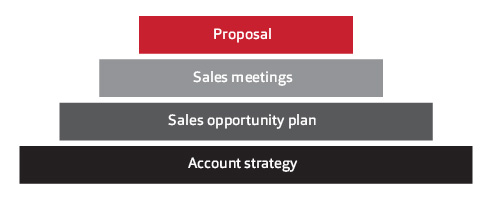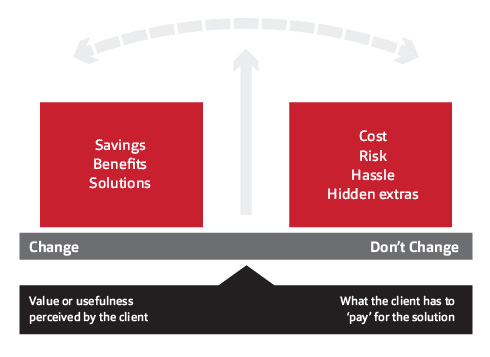Proposals are one of the most neglected elements of the sales process and one that will handsomely repay the time and effort committed to making them more effective.
Perception and reality The role of the proposal The decision making process Producing better proposals Building value Demonstrating return on investment Reducing concerns Making information easy to find Standing out from the crowd Taking action Download this whitepaper
When we talk to most organisations and their salespeople about proposals, many will admit it is an area they pay little attention to and assume that what they already produce is fine. When we then help them to analyse a few of their proposal documents their view usually changes, often dramatically.
-
Over 50% of salespeople would not buy the solution they proposed based on the case put forward in their own proposal document were they in the customer’s shoes.
-
75% of salespeople find some of the pages in their own proposal documents so boring, even they skip over them.
-
The vast majority of the benefits stated in the proposal can be claimed by any supplier.
-
Few proposals contain figures showing the return on the investment the customer can expect in financial terms, making it difficult to compare the value of the proposal with the cost.
-
The majority of proposals fail to make links between the customer’s needs and the solution being offered.
These findings are based on the work we have done with clients where we asked them to analyse their own proposals. Most were shocked by the results and were galvanised into taking immediate steps to rectify the situation.
Why should there be such a mismatch between perception of the quality of proposals and reality?
Perhaps the starting point lies in salespeople’s attitudes to writing proposals. Mention the subject to most salespeople and their eyes either glaze over or a haunted look appears on their faces. Many see writing a proposal as a necessary evil, to be completed as quickly as possible with the minimum of effort. In terms of training and development it appears well down the list, with organisations much more willing to invest in strategic selling or face-to face selling skills. Most salespeople have received little or no training in proposal writing.
This is a strange state of affairs, since if we look at the hierarchy of events leading to a successful sale we see a very different picture.

The role of the proposal in high value, complex sales
All the strategic planning and face-to-face selling skills count for little, if the proposal we produce fails to get us onto the shortlist. This is an absolutely crucial document that can make or break a sale. The lack of investment in this area stems from a lack of understanding of the important part the proposal plays in the customer’s decision making process, and of just how poor most proposals are in meeting the demands placed upon them.
The role of the proposal in high value, complex sales
When we ask salespeople “what do you hope the proposal will do for you?” we usually get the following answers:
-
Win the business
-
Present a strong case for our solution
-
Show that we are better than the competition
-
Persuade the senior people we haven’t been able to meet face-to-face to go with us
-
Sell for us when we are not there.
Sadly, when we then help the same people to review the documents they have produced, most admit that their proposal is ill equipped to meet those objectives. Why is this? There seems to be three main reasons:
-
Time pressure from customers to produce the proposal to a tight deadline means the work is often rushed
-
The availability of modern technology makes it easy to cut and paste sections from previous documents, or to use standard text to produce proposals quickly. This often results in a proposal that is little more than a ‘feature dump’ about the supplier’s company, products and services, with a price tag attached
-
A lack of understanding of the role the proposal can play in the customer’s decision making process, with the result that too little thought goes into the construction of the document.
Let’s look further at this decision making process and the role of the proposal
In high value, complex sales there is usually a need to influence a range of people in the customer account, often including senior managers at Board level. Most sellers find it difficult, if not impossible, to meet all these people face-to-face; so they either have to try to influence them through the other people they have met or via the documents they submit. In some cases the proposal may be the only direct route for influencing the most senior decision-makers.
In such sales the buying decision is often taken by a group who will be faced with making a choice between several suppliers all with the capability to supply a solution. The most frequently travelled route when faced with this situation is to make a shortlist of suppliers. For the salesperson this is a crucial cut-off point. Failure to make the shortlist is effectively the end of the sale, surviving the cull is crucial.
The decision to shortlist a supplier will be based on the individual perceptions of group member’s of how well each supplier matches his or her needs and decision criteria. For those decision-makers who have not met the seller in person, their perception of the supplier will be based on what they have heard from others and what they have read in the proposal, if of course, they bothered to read it at all. So the proposal can be a key document for influencing these people, if it is read and if it is persuasive.
To be effective it needs to be:
-
attractive so that people want to pick it up and read it
-
easy to read so that people can find information easily and extract key messages quickly
-
persuasive so that it presents an overwhelming case for the customer to accept the proposed solution.
So how can we produce better documents?
The first step is to be clear about the job they need to do. The diagram below shows some of the issues the customer is trying to weigh up when making a decision.

If we look at the left hand side of the balance, the customer is weighing up his or her perceptions of the size of the problems they are trying to solve, the importance of the needs they are trying to meet and the likely return on the investment in the solution. Balanced against this are perceptions of the cost of the solution, the effort or hassle involved in implementing the solution, and the risk involved in doing something new and different. To be persuasive, the proposal needs to clearly set out the issues on the left hand side of the balance and show how the solution can be implemented with the minimum hassle and risk. In short, it needs to set out a clear business case for change.
Building the left hand side of the balance
To build a strong business case we need to summarise the customer’s problems and needs to ensure that anyone reading the document can clearly see and understand the need for action. Remember that some of the people on the decision making group may not be directly impacted by these issues, so summarise any knock-on effects of the problems that impact on their departments. This help will bring their support for the proposal. Show clearly how your solution will solve these problems and meet the needs. Don’t forget to show proof to back up your claims wherever possible, simply saying you can do something isn’t very persuasive. Summarise the benefits that will flow from your solution, and where possible show that these benefits are not just for the main problem owners but can have a wider impact for the business as a whole. In other words, try to show all the decision-makers there is something in it for them and their departments.
Show the return on the investment they are making
Remember that the cost of your solution will be plain to see when people read the document. Try to express the benefits in financial terms, whenever possible, so customers can see the expected return on investment. Failure to do this can mean your proposal is rejected as too expensive.
At the beginning of this paper we stated that in most of the proposals Huthwaite see there are few financial benefits, so if you can give the customer a clear picture of the financial return on their investment you are likely to give yourself a distinct competitive advantage.
Try to minimise the impact of the right hand side of the balance
As we can see, the customer is likely to be concerned about the cost, risk and sheer hassle of implementing a new solution. We can’t do much to reduce the impact of the price and we are certainly not suggesting you reduce its impact by discounting! However, it is worth taking some time to check the pricing information supplied, as too much detail can provide the customer with ammunition to use against you in later negotiations. We can reduce concerns about the risk and hassle of implementation by having a clear implementation plan setting out exactly what needs to happen, by whom and when, to ensure the implementation is a success. If it is known that there will be specific problems in implementing the solution, setting out how these will be addressed can give the customer reassurance that your organisation knows what it is doing.
Finally, the quality of our references can help to reassure the customer that they will be placing themselves in capable hands if they adopt you as their supplier.
Having a persuasive case is of little value if people can’t find the information
Having prepared a persuasive case, the next step is to make this information as accessible as possible so that the decision-making group can find and discuss key information quickly and easily. To achieve this, a clear structure and index are vital. More than that, we need to use a range of devices to draw attention to key information we want people to read. This is where the use of graphics, photos, headlines and colour can all help to make key information stand out. The old adage that a picture is worth a thousand words is worth remembering when it comes to presenting important information. Showing the customer we can save millions is of no value at all if the numbers are buried in a mountain of text.
Producing a persuasive document is a waste of time if no one reads it
Finally, the proposal needs to stand out from the crowd so that people want to pick it up and read it. Show any audience a pile of proposals and invite them to select one to read first and they will usually go for the one that looks attractive and is not too bulky. We have been surprised to find that even organisations known to be fiercely proud and protective of their corporate image have no common standards for the look and feel of their proposals, and yet this document is the physical embodiment of their organisation when it sits on the decision-maker’s desk.
Making the document look attractive is a good step forward, since it might at least help to catch the potential readers eye. Having attracted attention we need to add something which makes them want to open it. This is where a bold heading could make all the difference. For example, compare the impact of “A proposal to improve inventory management for Bloggs and Co” with “Saving Bloggs and Co £1000 000 on inventory”. Which do you think is more likely to be read? The example may be a little extreme but we hope the message is clear, use headlines to make people want to read the content.
Take action to ensure key people actually read it
Relying solely on the document’s appearance to attract the reader’s interest is a dangerous strategy. Senior decision-makers are busy people, with many other demands on their time, most of which carry far greater and more immediate penalties for a lack of attention than failing to read a proposal. Give some consideration to the other actions you can take to ensure all the people you want to read your proposal actually do so. For example, if you have a good internal sponsor or some strong supporters you may want to work with them to plan a joint strategy for ensuring all the key people receive individual attention, with the aim of ensuring they do read the document.
Closing remarks
From all the work we have done in this area we know there is potential for customers to make significant and quick wins from addressing these issues. It is one of those areas where it is relatively easy to bring about an immediate improvement since a template can be constructed to guide people to write better documents. It is also easier for managers to review proposals than to observe any other aspect of their sales team’s performance.







